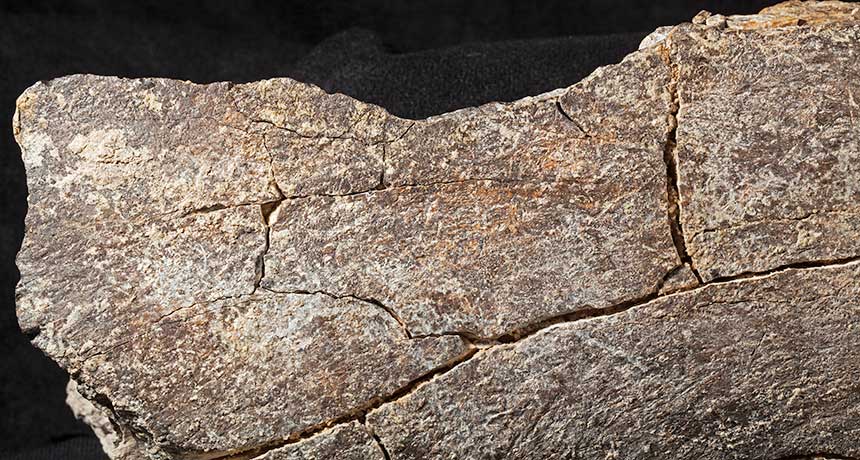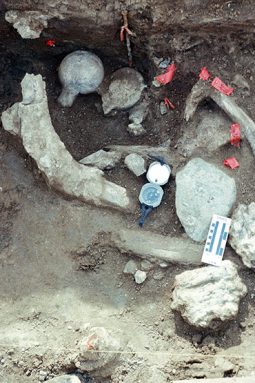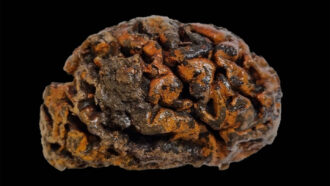America’s first settlers may have arrived 130,000 years ago
Mastodon bones, stone tools place unknown Homo species in California surprisingly early

An unidentified Homo species pounded apart mastodon bones with large stones in southern California around 130,700 years ago, a new study concludes. Finds at what’s proposed as the oldest archaeological site in the Americas include this mastodon leg bone.
T. DEMÉRÉ/SAN DIEGO NATURAL HISTORY MUSEUM
By Bruce Bower
Astoundingly ancient stone tools and animal bones have just turned up at a site in California. If the discoverers are correct, these remains point to the presence of humans or some ancestral species in the Americas 130,700 years ago. That’s a whopping 100,000 years earlier than research had suggested until now.
The new artifacts were found at the Cerutti Mastodon site. It’s near what is now San Diego. Scientists described these bones and tools online April 26 in Nature.
Their new date for the artifacts has stirred up a ruckus. Indeed, many scientists are not yet ready to accept those dates.
The new assessment comes from a research team led by archaeologist Steven Holen and paleontologist Thomas Deméré. Holen works at the Center for American Paleolithic Research in Hot Springs, S.D. His colleague works at the San Diego Natural History Museum.
Some 130,000 years ago, the researchers say, the climate was relatively warm and wet. That would have submerged any land connection between northeastern Asia and what’s now Alaska. So ancient folk migrating to North America must have reached the continent in canoes or other vessels, they say. Then these folk could have traveled down the Pacific coast.
Candidates for southern California’s mastodon-bone breakers include Neandertals, Denisovans and Homo erectus. All are hominids that lived in northeastern Asia some 130,000 years ago. A less likely possibility, Holen says, is our species — Homo sapiens. That would be surprising, as there is no evidence that true humans reached southern China before 80,000 to 120,000 years ago.
For now, the tool users who inhabited the Cerutti Mastodon site remain unknown. No fossils of those folk have turned up there.
Whatever Homo species reached the Cerutti Mastodon site probably broke apart the huge beast’s bones to obtain the nutritious marrow. Afterward, the scientists suspect, these folk likely would have turned limb fragments from the animals into tools. Hominids probably scavenged the mastodon carcass, the scientists point out. After all, they add, the animal’s bones showed no scrape or slice marks from stone tools. Those marks would have been left if these folk had butchered the animal.
Skeptics weigh in
Researchers already disagree about whether humans reached the Americas more than 20,000 years ago, so it’s not surprising that the new report is controversial. Indeed, critics quickly questioned the new claim.
Excavation of the mastodon site occurred in 1992 and 1993. This was after the site became partially exposed during a construction project. Backhoes and other heavy construction equipment can cause the same damage to mastodon bones that the new report attributes to an ancient Homo species, notes Gary Haynes. He’s an archaeologist at the University of Nevada, Reno.
The ancient southern California landscape also may have included streams. These could have washed broken mastodon bones and large stones from separate areas. They might simply have collected at the spot where they were eventually unearthed, says Vance Holliday. Also an archaeologist, he works at the University of Arizona in Tucson.
Perhaps hominids used stones found at the site to break bones, he says. Still, the new study doesn’t rule out other explanations. For instance, the bones might have suffered a trampling by animals at locations where the bones originated. “Making a case for [hominids] on this side of the Pacific Ocean at 130,000 years ago is a very heavy lift,” Holliday argues. “And this site doesn’t make it.”
Michael Waters is an archaeologist at Texas A&M University in College Station. Nothing at the mastodon site clearly qualifies as a stone tool, he argues. Indeed, he adds, mounting genetic evidence indicates that the first people to reach the Americas — the ancestors of present-day Native Americans — arrived no earlier than about 25,000 years ago.
But the new study’s authors say such certainty is not warranted. “The evidence is incontrovertible” for earlier Americans, argues coauthor Richard Fullagar. He works in Australia at the University of Wollongong. Team member James Paces of the U.S. Geological Survey in Denver made measurements of natural uranium and its decay products in mastodon bone fragments. And those data, Fullagar explains, enabled his team to estimate their age.
What they found
A sediment layer at the San Diego site contained pieces of a mastodon’s limb bones. Ends of some bones were broken off. This likely would have been done so that the tasty marrow could be removed. The bones lay in two clusters. One set was near two large stones. The other bone cluster was spread around three large stones. These lumps of rock ranged from 10 to 30 centimeters (4 to 12 inches) in diameter.

Holen’s team used stones lashed to branches to break elephant bones resting on large rocks. They were trying to mimic what ancient folk might have done. Damage to the test stones that were used as hammers resembled three stones found at the mastodon site. The researchers conclude that those older stones had been used to bash mastodon bones.
Also at the site were molar teeth and tusks. These bore marks that could have been left by repeated battering by large stones, the team says.
Construction machinery produces distinctive damage to large bones. And those patterns were not seen on the mastodon remains, Holen says. What’s more, the bones and stones had been about three meters (10 feet) below the area originally exposed by the earth-moving equipment.
Holen’s group also notes that sediment found at the mastodon site show no signs of having washed the animal bones and stones in from elsewhere. It’s unlikely too, they say, that trampling or gnawing by animals would have left bone damage of the type seen.
Erella Hovers of the Hebrew University of Jerusalem takes a cautiously positive view. Despite uncertainties about who busted mastodon remains on the Pacific coast so long ago, she says the specimens do appear to most likely have been broken by members of a Homo species. Stone Age hominids may have reached “what now seems to be a not-so-new New World,” Hovers concludes. She shared her views in the same issue of Nature.







